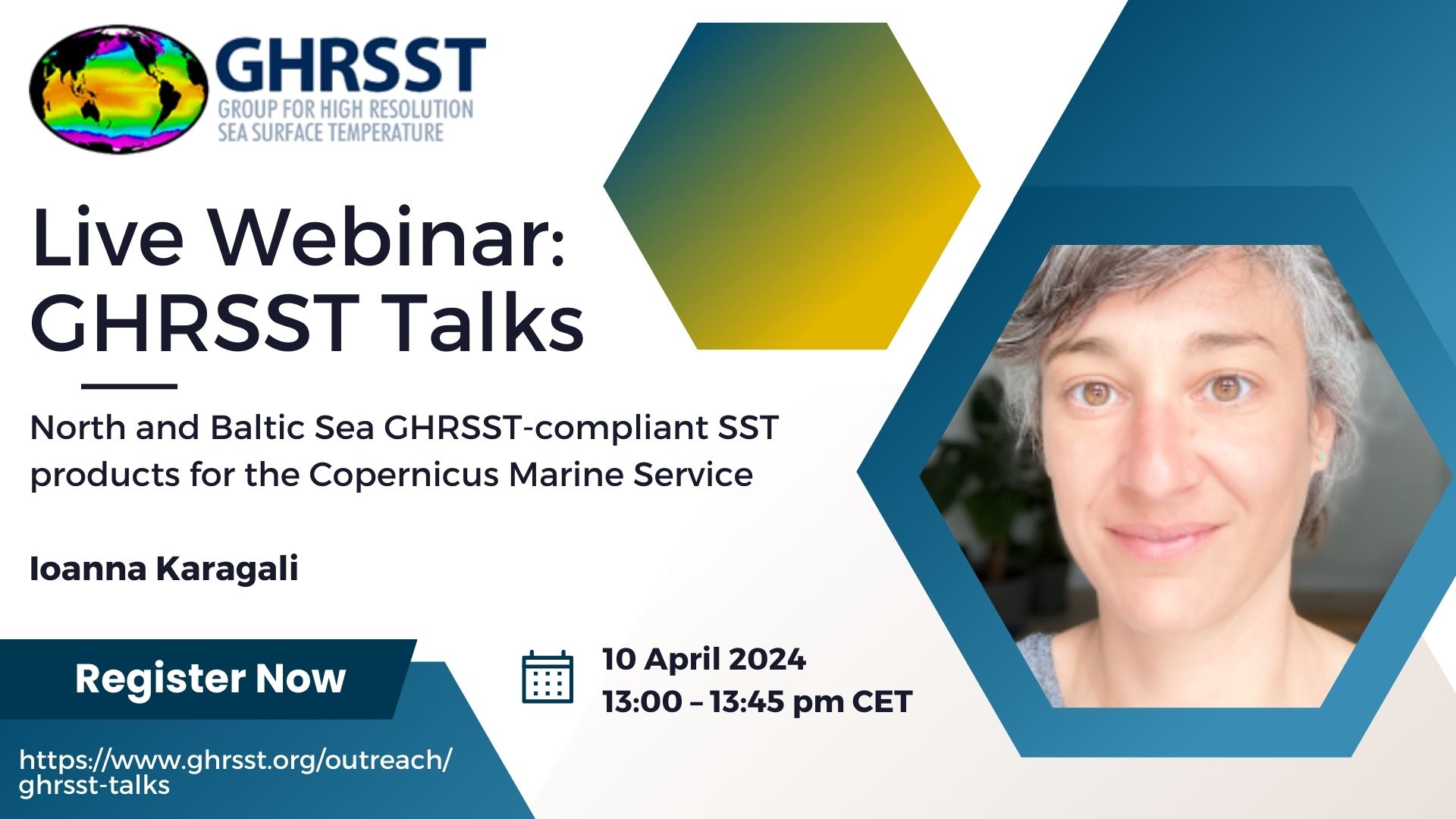Please join us for this GHRSST Talk with Ioanna Karagali on:
North and Baltic Sea GHRSST-compliant SST products for the Copernicus Marine Service
Authors: Ioanna Karagali (1), Magnus Barfod Suhr (2), Wiebke M. Kolbe (3), Pia Nielsen-Englyst (4), Jacob L. Høyer (5)
(1) DMI, Lyngbyvej 100, Copenhagen Ø, 2100, Denmark, Author email address: ika@dmi.dk
(2) DMI, Lyngbyvej 100, Copenhagen Ø, 2100, Denmark, Author email address: msu@dmi.dk
(3) DMI, Lyngbyvej 100, Copenhagen Ø, 2100, Denmark, Author email address: wk@dmi.dk
(4) DMI, Lyngbyvej 100, Copenhagen Ø, 2100, Denmark, Author email address: pne@dmi.dk
(5) DMI, Lyngbyvej 100, Copenhagen Ø, 2100, Denmark, Author email address: jlh@dmi.dk
Abstract
Satellite missions carrying Thermal Infrared (TIR) and Passive Microwave Sensors (PMW) allow for high-resolution SST retrievals under clear skies (TIR) and all weather retrievals (PMW) albeit with coarser resolution. This allows the continuous provision of SST to operational Numerical Weather Prediction systems, climate models and to the wider scientific community. DMI is a Production Unit (PU) for the SST Thematic Assembly Center (TAC) of the Copernicus Marine Monitoring Service (CMS) providing a suite of level 4 SST products for the Baltic and North Sea daily, hourly and as multi-year products.
The L4 Near-Real-Time (NRT) SST product SST-BAL-SST-L4-NRT-OBSERVATIONS-010-007-b is a daily, multi-sensor, gap-free, optimally interpolated product derived from night-time SST retrievals at high resolution (0.02o), available from 2016 onward. The L4 Multi-Year SST product SST-BAL-SST-L4-REP-OBSERVATIONS-010-016 is a daily, multi-sensor, level 4 optimally interpolated product using infra-red satellite observations from the ESA CCI and Copernicus C3S projects and high resolution sea ice information from SMHI and the Copernicus Marine Service Sea Icea (SI) TAC available from 1982 to 2022. The L4 Near-Real-Time Diurnal SST product SST-BAL-PHY-SUBSKIN-L4-NRT-010-034 is an hourly, gap-free satellite sub-skin SST analysis using L2P and L3 single-sensor SST data as input. Within the next C3S portfolio, DMI will provide the SST ECV, i.e. a global (up to 90o latitude), sub-skin product (20 cm) with a 0.05o spatial resolution. The aim of the present study is to provide an overview of the available products and their performance along with insights on future developments and products.
About Ioanna
Dr. Karagali handles the production and dissemination of Copernicus Marine Service SST and IST products for the North Sea/Baltic Sea and the Arctic. She holds a PhD in Remote Sensing for Meteorology and Oceanography and is currently a Senior Consultant at the Danish Meteorological Institute where she is responsible for research, dissemination, coordination, and project management. Prior to DMI, Ioanna held positions as a Post-Doc and Senior Researcher at the Danish Technological University in Copenhagen.
With a strong focus on satellite-based sea surface temperature (SST) research, Dr. Karagali has an extensive background in analyzing L4 products, mostly regional and high-resolution data, for validation with in-situ measurements, analysis of diurnal warming and climate trends. A crucial aspect of Dr. Karagali’s expertise lies in understanding of L4 products generated from L2 and L3 data, as well as having interest in SST, IST, winds, oceanography, remote sensing, and ocean and atmospheric modelling.
Watch Ioanna’s GHRSST Talk
Download Ioanna’s presentation on the GHRSST Zenodo Community here.

